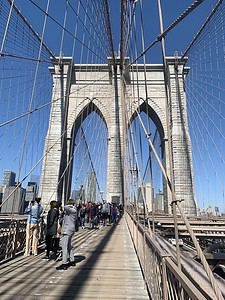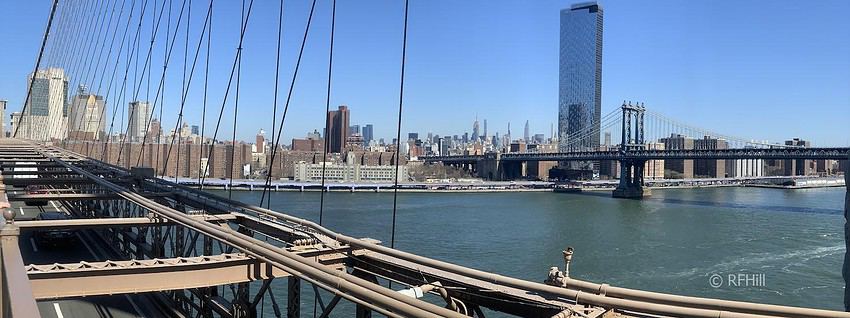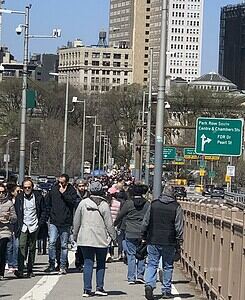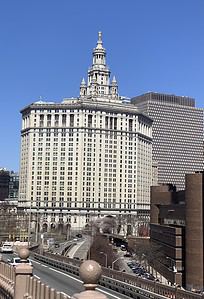Are you looking for a stunning view of the New York skyline that will take your breath away? Well, look no further than the Brooklyn Bridge! This iconic landmark has been a symbol of New York City for over 100 years, and it’s an engineering marvel that continues to amaze visitors today. So wear your walking shoes, charge your camera, and prepare for an unforgettable experience!
Brooklyn Bridge History
The Brooklyn Bridge was completed in 1883 and was the first suspension bridge to use steel cable in its construction. It was designed by John A. Roebling, a German immigrant and engineer who unfortunately died before the bridge was completed. His son, Washington Roebling, took over as chief engineer and oversaw the completion of the project.
It took over 14 years to build the Brooklyn Bridge, which spans 1,595.5 feet, costing $15.5 million, equivalent to over $380 million today. The bridge spans the East River and connects the boroughs of Brooklyn and Manhattan, making it a vital transportation link for commuters and tourists alike.
Interesting Facts
One of the most interesting facts about the Brooklyn Bridge is that it was built when many people believed steel structures would collapse under their own weight. To dispel these fears, the designers of the Brooklyn Bridge employed a unique design that used steel wire cables to support the bridge’s weight. P. T. Barnum, the famous circus owner, marched 21 elephants across the bridge in 1884 to prove its stability.
These cables were woven together to create a strong and durable structure that could withstand the weight of traffic and the forces of nature. The steel cables were made by John A. Roebling’s company, Roebling Wire Works, which also supplied the cables for the George Washington Bridge and the Golden Gate Bridge.
Today, the Brooklyn Bridge is a beloved landmark that draws visitors from all over the world. Whether you’re walking across the bridge or admiring it from a distance, there’s no denying it’s a stunning sight to behold. The bridge is so popular that it sees an average of 10,000 pedestrians and 3,500 cyclists crossing it daily!
If you want to avoid crowds, try visiting early in the morning or late in the evening. The bridge is busiest during the middle of the day, so plan accordingly. And don’t forget to bring your camera! The views from the bridge are stunning, and you’ll want to capture them for posterity.
Practical Stuff

The bridge’s wooden planks can be slippery, especially if it has rained, and you don’t want to risk slipping and injuring yourself. Personally, I like the wooden planks as they are less harsh on the legs than concrete.
You’ll also want to dress appropriately for the weather, as it can get windy and chilly on the bridge.
One thing to remember when walking across the Brooklyn Bridge is that it’s a suspension bridge that moves slightly as traffic passes. Don’t worry, it’s perfectly safe, but if you’re afraid of heights or have balance issues, you may want to take it slow and hold onto the railing.
Walking across the Brooklyn Bridge is an experience despite the crowds
Be prepared for crowds. The Brooklyn Bridge is a popular destination for tourists and locals, so that it can get unbelievably crowded, especially during peak tourist season.
If you want to avoid crowds, try visiting early in the morning or late in the evening. The bridge is busiest during the middle of the day, so plan accordingly. And don’t forget to bring your camera! The views from the bridge are stunning, and you’ll want to capture them for posterity.
I was surprised to find so many people walking up the bridge alongside the many vendors, even on a weekday.
If you want to learn more about the Brooklyn Bridge’s history, I recommend taking a guided tour. Several companies offer walking tours of the bridge, and they can provide you with fascinating insights into its construction and history.
There are a variety of tours available, including walking tours, bike tours, and even food tours that take you to some of the best restaurants in the area. These tours are a great way to learn more about the bridge’s history and the surrounding neighbourhoods. You might be able to find some paid apps for your smartphone that suit you.
Walking across the bridge, you’ll notice separate dedicated lanes for pedestrians and cyclists. There used to be both pedestrian and bike lanes, but this proved dangerous. Looking down, you can still faintly see the marking for both. Now you do not need to worry about cyclists as they have a separate roadway.
The views of the Manhattan skyline are simply breathtaking. You can see the Empire State, Chrysler, and One World Trade Center in the distance. You can also glimpse the Statue of Liberty from certain angles. It’s a great way to get a different perspective of the city and appreciate the beauty of its architecture.
Finally, don’t forget to take some time to explore the areas around the Brooklyn Bridge. The Brooklyn Heights neighbourhood, located on the Brooklyn side of the bridge, is home to some of the city’s most charming brownstones and picturesque streets. On the Manhattan side, you’ll find the South Street Seaport, a historic district with shops, restaurants, and a maritime museum.
Walking the Brooklyn Bridge is a must do in my books.



